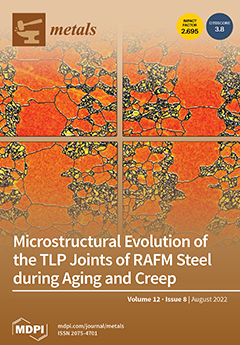In the present study, the effect of γ′-phase dispersed particles on both the L2
1(B2)-10M/14M-L1
0 martensitic transformations and the elastocaloric effect in aged Ni
54Fe
19Ga
27 single crystals oriented along the [001]-direction was investigated. It was experimentally shown
[...] Read more.
In the present study, the effect of γ′-phase dispersed particles on both the L2
1(B2)-10M/14M-L1
0 martensitic transformations and the elastocaloric effect in aged Ni
54Fe
19Ga
27 single crystals oriented along the [001]-direction was investigated. It was experimentally shown that aging strongly affects the elastocaloric properties of these crystals. The precipitation of semi-coherent γ′-phase particles up to 500 nm in size in the crystals aged at 773 K for 1 h leads to a 1.4 times increase in the operating temperature range of the elastocaloric effect up to ΔT
SE = 270 K as compared with the initial as-grown crystals (ΔT
SE = 197 K). The adiabatic cooling values ΔT
ad are similar for the as-grown crystals ΔT
ad = 10.9 (±0.5) K and crystals aged at 773 K ΔT
ad = 11.1 (±0.5) K. The crystals containing incoherent γ′-phase particles sized 5–35 μm (after aging at 1373 K for 0.5 h) possess an operating temperature range of ΔT
SE = 255 K with slightly smaller adiabatic cooling ΔT
ad below 9.7 (±0.5) K. The aged [001]-oriented Ni
54Fe
19Ga
27 single crystals demonstrate high cyclic stability: the number of cycles does not influence the adiabatic cooling values and parameters of loading/unloading curves regardless of the particle size. The ways to improve the elastocaloric cooling parameters and stability of the elastocaloric effect by means of dispersed particles in the NiFeGa ferromagnetic shape memory alloy were discussed.
Full article





